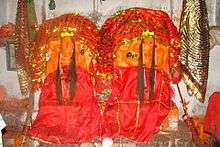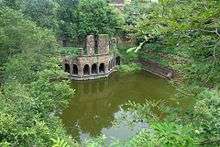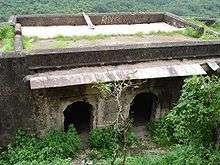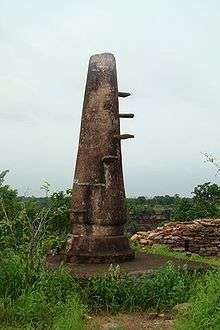Hinglajgarh






Hinglajgarh (Hindi: हिंगलाजगढ़) or Hinglaj Fort (Hindi: हिंगलाज क़िला Hinglaj Qila) is an ancient fort situated near village Navali in Bhanpura tehsil of Mandsaur district in Madhya Pradesh. Its coordinates are latitude 25°30' N and Longitude 65°31' E. It is situated 165 km from Mandsaur town and 26 km from Bhanpura town in Madhya Pradesh.[1] This fort was at its peak of grandeur during Parmara rule.[2] There are many artistic sculptures of various periods in this fort. The Nandi and Uma-Maheshwar sculptures were sent from there to France and Washington for display in India festivals and left a mark at international levels.[3] The Hinglajgarh was the centre of excellence in craftsmanship of sculptures for about 800 years. The statues recovered from this fort are from the Guptas period to Parmara period. The most ancient statues are from 4th–5th century AD.[4]
Origin of name
Hinglajgarh gets name after the goddess Hinglaj Devi, the kuldevi of Kshatriyas & Brahamkshtriya Marwari Khatri Hinglaj Mata temple is situated in the Hinglajgarh.[5] Originally temple located at Hinglaj (Urdu: ﮨنگلاج) is an important Hindu pilgrimage place in Balochistan, Pakistan. It is situated in Balochistan province about 250 km north-west of Karachi.[6] The Kshatriyas in ancient times had movements between baluchistan and India. The Mauri rulers founded the temple of Hinglaj Mata as she was their kuladevi. Initially this area was known as 'Hinglaj Tekri' but later the Mauri rulers built a fort here and this came to be known as Hinglajgarh or Hinglaj Fort.[3][7]
History
Hinglaj Fort became very strategic during the Parmara rule and they strengthen it. In 1281 the Hada ruler halu occupied it, and later it came under Chandrawat rulers. Mention of Haveli of Gopal Singh, a Chandrawat ruler, is found in the patnama of Chandrawats.[8] In 1773 the Holkar Queen Ahilya Bai defeated Laxman Singh Chandrawat and occupied it. The fort was renovated during Holkar rule along with Hinglaj Mata Temple, Rama Temple, and Shiva Temple. Though various dynasties occupied the fort but it was never used as a permanent capital. It was mainly used as a shelter by various rulers. This is the reason why there are not many palaces here.[9]
The Hinglaj Fort has four gates namely Patanpol, Surajpol, Katrapol and Mandaleshwaripol. The first three gates (pol) are east facing whereas last, Mandaleshwaripol, is west facing. There is storage of water in a grand tank known as Surajkund. Local tradition goes that Gotri Bhil was killed here, therefore the smarak built here is worshiped by Bhils.[9]
In the southern part of the Hinglaj Fort is situated Hinglaj Mata temple, Rama-Hanuman Temple, Darbar Kaksha (Kachhari), Rani Mahal and Shiva Temple. There is a big Burj here known as Fateh Burj.[10] There are also two towers called Tirtham, which used to be used as means of communication with distant places through light.
References
- ↑ Rajendra Verma:Mandsaur District Gazetteer, p. 289
- ↑ Ramlal Kanwal:Prachin Malwa mein Vastukala, p. 185
- 1 2 Usha Agarwal:Mandsaur Zile Ke Puratatvik samarakon ki paryatan ki drishti se sansadhaniyata - Ek Adhyayan, Chirag Prakashan Udaipur, 2007, p. 38
- ↑ Usha Agarwal:Mandsaur Zile Ke Puratatvik samarakon ki paryatan ki drishti se sansadhaniyata - Ek Adhyayan, Chirag Prakashan Udaipur, 2007, p. 42
- ↑ L.D.Dhariwal (Ed): Indore State Gazetteer, Vol. 2, p. 24
- ↑ Hindus in Pakistan - BBC News
- ↑ Puran Sahgal:Dashpur Janapad mein Arawali ke Sudrarh Durg Prachir, Shodh Patra, Sangoshthi, Mandsaur, 1991, p. 104
- ↑ News Letter Published by Intec No. 1, Nimach Hinglajgarh Chapter, March April 1991, p. 10
- 1 2 Usha Agarwal:Mandsaur Zile Ke Puratatvik samarakon ki paryatan ki drishti se sansadhaniyata - Ek Adhyayan, Chirag Prakashan Udaipur, 2007, p. 39
- ↑ Usha Agarwal:Mandsaur Zile Ke Puratatvik samarakon ki paryatan ki drishti se sansadhaniyata - Ek Adhyayan, Chirag Prakashan Udaipur, 2007, p. 40
Coordinates: 24°40′N 75°47′E / 24.667°N 75.783°E